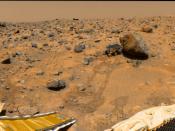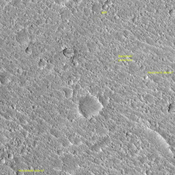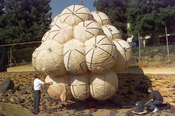The History of Mars
The planet mars is the fourth planet from the sun and the seventh largest planet in out solar system, and at nighttime, Mars is easily visible with the unaided eye. The planet is approximately 1.52 Astronomical Unites (AU) from the sun, or 227,940,000 km. The original word Mars came from the Greek word, meaning the God of war. The planet?s name most likely originated from its red color, which is also the reason for why it is referred to as ?the Red Planet?. The name of the month March derives from Mars (Foundation of Astronomy 484-499).
Though Mars is much smaller than Earth, its surface area is about the same as the land surface area of Earth. Mars' orbit is significantly elliptical. This has a major influence on Mars? climate. While the average temperature on Mars is about -55ð C, Martian surface temperatures range widely from as little as -140ð C at the winter pole, to almost 20ð C on the dayside during summer (Foundation of Astronomy 484-499).
With the exception of the Earth, Mars has one of the most interesting and stunning terrains of any planet in our solar system. Olympus Mons is the largest mountain in our solar system rising approximately 78,000 feet. Tharsis is a huge bulge on the Martian surface that is about 4000 km across and 10 km high. Much of the Martian surface is cratered, but Hellas Planitia in a huge crater in the southern hemisphere, which is over six km deep. Valles Marineris is the famous system of canyons 4000km long, which appears on mars surface.
(http://seds.lpl.arizona.edu/nineplanets/nineplanets/mars.html).
There are signs of erosion on Mars including large floods and small river systems. At some time in the past there was clearly liquid on the surface. Liquid water seems to...


